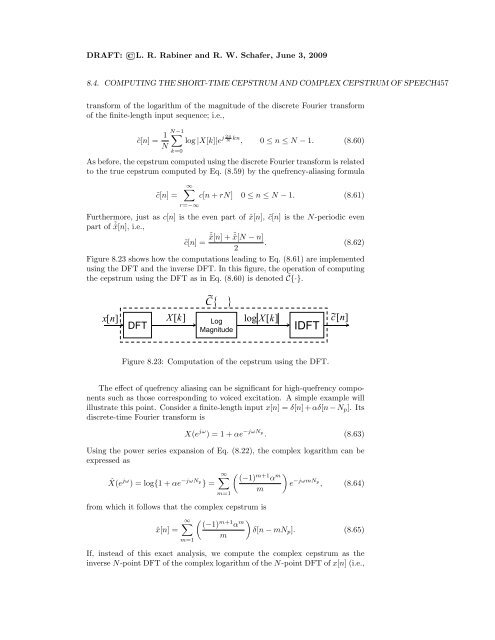LR Rabiner and RW Schafer, June 3
LR Rabiner and RW Schafer, June 3
LR Rabiner and RW Schafer, June 3
You also want an ePaper? Increase the reach of your titles
YUMPU automatically turns print PDFs into web optimized ePapers that Google loves.
DRAFT: L. R. <strong>Rabiner</strong> <strong>and</strong> R. W. <strong>Schafer</strong>, <strong>June</strong> 3, 2009<br />
8.4. COMPUTING THE SHORT-TIME CEPSTRUM AND COMPLEX CEPSTRUM OF SPEECH457<br />
transform of the logarithm of the magnitude of the discrete Fourier transform<br />
of the finite-length input sequence; i.e.,<br />
˜c[n] = 1<br />
N−1 <br />
N<br />
k=0<br />
2π j<br />
log |X[k]|e N kn , 0 ≤ n ≤ N − 1. (8.60)<br />
As before, the cepstrum computed using the discrete Fourier transform is related<br />
to the true cepstrum computed by Eq. (8.59) by the quefrency-aliasing formula<br />
˜c[n] =<br />
∞<br />
r=−∞<br />
c[n + rN] 0 ≤ n ≤ N − 1. (8.61)<br />
Furthermore, just as c[n] is the even part of ˆx[n], ˜c[n] is the N-periodic even<br />
part of ˜ˆx[n], i.e.,<br />
˜c[n] = ˜ˆx[n] + ˜ˆx[N − n]<br />
. (8.62)<br />
2<br />
Figure 8.23 shows how the computations leading to Eq. (8.61) are implemented<br />
using the DFT <strong>and</strong> the inverse DFT. In this figure, the operation of computing<br />
the cepstrum using the DFT as in Eq. (8.60) is denoted ˜ C{·}.<br />
C { }<br />
~<br />
x[ n ] X [k]<br />
log X [ k]<br />
DFT<br />
Log<br />
Magnitude<br />
IDFT<br />
Figure 8.23: Computation of the cepstrum using the DFT.<br />
c~<br />
[ n]<br />
The effect of quefrency aliasing can be significant for high-quefrency components<br />
such as those corresponding to voiced excitation. A simple example will<br />
illustrate this point. Consider a finite-length input x[n] = δ[n] + αδ[n − Np]. Its<br />
discrete-time Fourier transform is<br />
X(e jω ) = 1 + αe −jωNp . (8.63)<br />
Using the power series expansion of Eq. (8.22), the complex logarithm can be<br />
expressed as<br />
ˆX(e jω ) = log{1 + αe −jωNp ∞<br />
<br />
m+1 m<br />
(−1) α<br />
} =<br />
e<br />
m<br />
−jωmNp , (8.64)<br />
m=1<br />
from which it follows that the complex cepstrum is<br />
∞<br />
<br />
m+1 m<br />
(−1) α<br />
ˆx[n] =<br />
δ[n − mNp]. (8.65)<br />
m<br />
m=1<br />
If, instead of this exact analysis, we compute the complex cepstrum as the<br />
inverse N-point DFT of the complex logarithm of the N-point DFT of x[n] (i.e.,
















